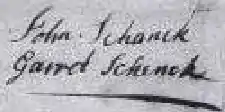John Schenck
John Schenck (sometimes written Schanck) (1750–1823) was a captain in the New Jersey Militia during the American Revolutionary War.

Background
Schenck was born in the now-defunct Amwell Township, Hunterdon County, New Jersey on May 26, 1750, the son of Gerret Roelofse Schenck (1719–1794) and Marytje van Sicklen (1722–1778). His ancestors were early Dutch settlers of New Amsterdam who had moved into New Jersey in the 1690s. In 1770, Schenck married Aida Sutphen (1754–1818), daughter of Aert Sutphen (1718–1798) and Jannetje Van Mater (1724-aft. 1798), whose ancestors were also part of the New Amsterdam Dutch settlement.
When Schenck died on his farm in Amwell Township, he left a sizeable estate. He is buried in Pleasant Ridge Cemetery, in what is now Raritan Township, along with his wife, parents and many of his children.[1] His marker reads "In memory of Captain John Schenck, who departed this life August 22, 1823, aged 73 years, 2 months and 27 days."
Military service
In 1775, Schenck was one of the first residents of Hunterdon County to volunteer to serve as a Minuteman in the months following the Battles of Lexington and Concord. He first served as a lieutenant and then was elected a captain of what was to become a company of the 3rd Regiment Hunterdon Militia. In eight years of service with the Militia, Captain Schenck fought in most of the major battles of the War in New Jersey and Pennsylvania. He was at the battles of Monmouth, Trenton, the Second Battle of Trenton (where he took command of another 3rd Regiment company after its lieutenants deserted and its captain fell sick), Princeton (where a cannonball took away a tree branch he had stooped to pass under), Bound Brook and Germantown.
Ambush of Geary
Captain Schenck is best remembered by the residents of Hunterdon County for a small skirmish (the Ambush of Geary, as it is called locally) that took place there on December 14, 1776. Arriving home on leave from Washington's army across the Delaware, Schenck was informed by a cousin that a scouting party of British dragoons were in the area. Schenck quickly assembled a party of irregulars from family members and neighbors and set an ambush for the British as they returned from their mission. Schenck and his party successfully took the dragoons by surprise and with their first volley killed the troop's officer, Cornet Francis Geary.
Whaleboat Raid on Flatbush
In June 1778, as retaliation for similar kidnappings by British troops and Loyalist forces of Continental officers, Schenck plus Captain William Marriner and a small team of men from Matawan launched a whaleboat from New Jersey to the coast of Brooklyn with the purpose of seizing Loyalist officials and figures with summer residences in and around Flatbush. The list included David Mathews, the Mayor of New York, Captain James Moncrief, and Theophylact Bache, President of the New York Chamber of Commerce. Schenck had prior deep knowledge of the area from his childhood.
Mathews was the first and primary target, but they were unsuccessful in securing him. At the home of British Captain Jacob Suydam they released from his home Captain Alexander Graydon, who had been held there as a prisoner of war. Suydam and Moncreif were successfully captured, and then Schenck and the crew successfully returned their men and prisoners to New Jersey without incident.[2]
References
- Wright, Terry. "Centennial nears for Pleasant Ridge Cemetery in Raritan Twp., burial site of N.J. notables", The Hunterdon County Democrat, March 27, 2013. Accessed May 29, 2013. "Then there are several Revolutionary war soldiers, the most famous of whom is Capt. (later Col.) John Schenck, who led a company at the Battle of Monmouth but is more famous locally as leader of the Amwell Militia against the British cavalry in the so-called 'Amwell Skirmish.'"
- Hornor, William S. This Old Monmouth of Ours, 1932, pages 32-35